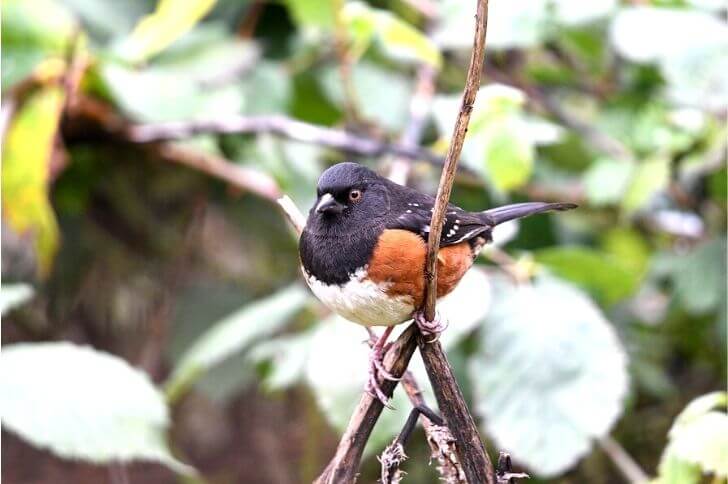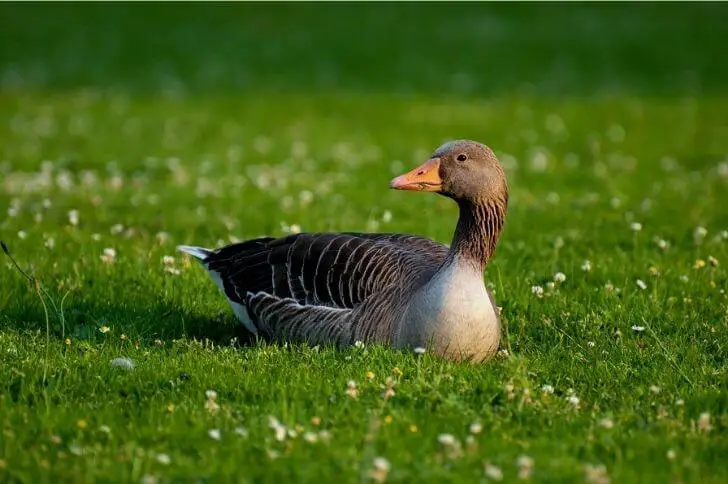Can you name a red bird with black wings? The most common bird that fits this category is the scarlet tanager. But did you know there are other avian species with similar coloring?
Below we’ll discuss other black winged red birds including the tanager. Learn their identification, preferred habitat, nesting habits and more. Whether you are a new birder or seasoned enthusiast, you’ll find the below list interesting.
List of Red birds with Black Wings
1. Scarlet Tanager (Male)
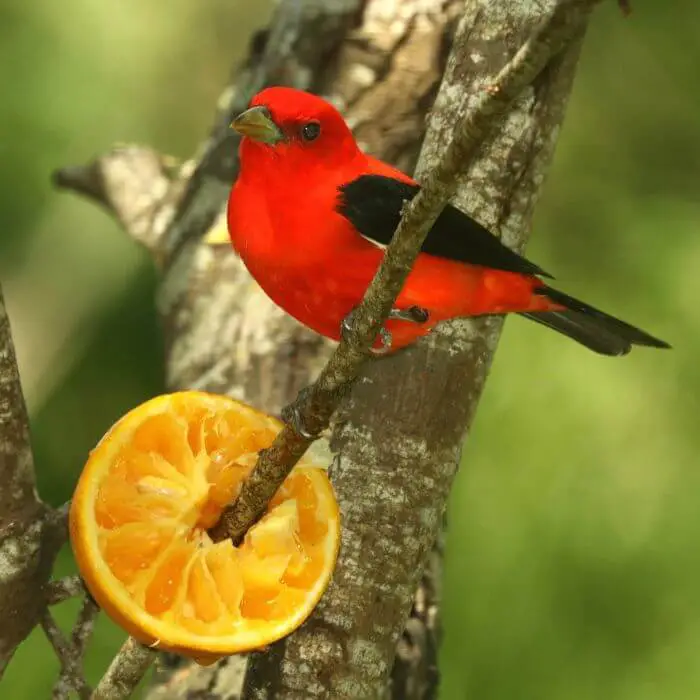
Identification:
The scarlet tanager is a brightly colored songbird that winters in South America, is a regular visitor to eastern states in summer and breeds in North eastern states . With its distinctive red plumage and black wings, the scarlet tanager is an eye-catching addition to any backyard bird watching expedition.
Adult females are olive-green in color with darker wings. Both sexes have fairly large heads and short thick bills.
Habitats:
Where can you go to see scarlet tanagers? These birds prefer wooded areas, especially deciduous forests, where they can perch in trees such as oaks and beeches.
In summertime you may spot them flitting from branch to branch as they forage for food before returning to their nests at nightfall.
Scarlet tanagers feed on flies, ants, beetles, grasshoppers, dragonflies, snails and spiders.
Nesting:
Nest construction takes anywhere from three to four days. Female scarlet tanagers lay 3-5 eggs which she’ll incubate for two weeks. Juveniles fledge after two weeks.
2. Pine Grosbeak

Identification:
With large chests and thick necks, pine grosbeaks are one of the largest members of the finch family.
This beautiful bird sports a red head, chest and back. Wings are black with white bars. Note the grayish undertail coverts and dark feet.
Female pine grosbeaks are overall gray with a yellowish head and rump. Notice the canonical bills and slightly notched tail.
Habitat:
The Pine Grosbeak can be seen year round in Canada’s boreal forests and mountainous regions of Alaska, its range extends south as far as New England during the winter months. During these cooler months, these birds form flocks which travel through deciduous or coniferous forests looking for food such as buds and berries which make up its diet during the wintertime.
Nesting:
When can you see pine grosbeak babies? This finch breeds from May to July and raises one brood each nesting season.
3. Vermilion flycatcher

Identification:
Known for their brood parasitism behavior, vermilion flycatchers are birds that range from Texas to Mexico. The species is sexually dimorphic.
Male birds have a red head and underparts and undertail. Back and wings and black. Female flycatchers are brownish gray above and a burnt orange bell. Their breasts are whitish.
Habitat:
Vermilion flycatchers can be found in farmlands, arid country, parks and scrublands.. These birds feed mainly on insects like flies, wasps, bees, beetles and caterpillars which they capture from branches or from midair sallies.
Nesting:
They construct their nests out of twigs which they line with soft materials like feathers or animal fur for insulation purposes. Vermilion flycatchers breed March to June, forming pairs that often remain together for multiple seasons.
They practice brood parasitism, laying eggs in other birds’ nests. Unlike grosbeaks, these birds can raise two to three birds per season.
4. Crimson sunbird

Identification:
Another sexually dimorphic red bird with black wings is the crimson sunbird. This beautiful species of sunbird has bright crimson-colored feathers on its head, back and chest, which give it its name. Belly is gray while the wings are dark gray to black. Note the long curved bill.
Females are smaller and dull olive-yellow. They also have a curved bill.
Habitat:
This captivating bird can be found in tropical areas across the Indian subcontinent and Southeast Asia. They can be found in farmlands as well as forests. Crimson Sunbirds primarily feed on nectar from flowers during the day, making them important pollinators. They also consume insects such as beetles and caterpillars. Their diet helps to maintain the balance of nature by controlling insect populations in their natural environment.
Nesting:
During nesting season, these red birds with black wings lay 2-3 eggs that are then incubated for 18-19 days.
5. Andean cock-of-the-rock
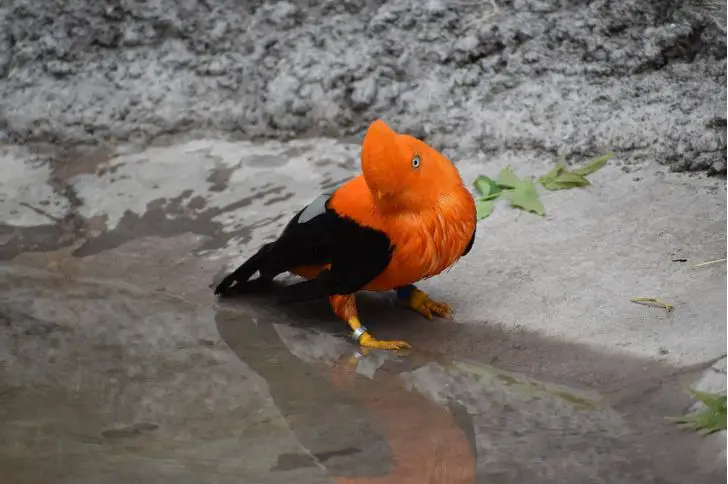
Identification:
The Andean cock-of-the-rock is an iconic and spectacular bird species found in the highlands of Peru, Ecuador, and Colombia. Its also has one of the longest and weirdest bird names in the avian world.
Its male is one of the most brightly colored birds in South America and is instantly recognizable by its vibrant orange-red crest that gives it its name. The rest of its body is also scarlet or bright orange with black wings and gray back.
The andean cock-of-the-rock female does not have a crest and is more duller than the male. This species has a short bill.
Habitat:
This species prefers to live in humid montane forests at altitudes between 4,900 and 10,800 feet. It feeds mainly on fruits such as berries and figs, as well as small insects or lizards.
Nesting:
The male andean cock-of-the-rock performs a variety of courtship rituals to attract potential mates. During breeding season, males will gather at leks (areas with few trees) and perform elaborate displays to impress nearby females.
These displays can include stilted walking, spreading their wings, bowing their heads low and calling out with loud sounds. After being impressed by one male’s performance, a female will choose her mate based on his size and beauty – the larger and more colorful he is the better! Note, males of these species are polygamous.
6. White-capped Redstart

Identification:
Another black and red bird you should know about is the white-capped redstart. A common bird in Southeast Asia, it is easily recognized by its distinct white crown and striking black plumage on its face, neck and back.
Habitat:
This little bird with red body and black wings has a penchant for wading into shallow waters in search of insects. You can spot it near rivers, lakes, and ponds in the mountains.
Nesting:
During mating season, a pair will construct their nest far away from water. They also prefer high areas. Females lay blue-green eggs and they can raise two clutches each season.
7. I’iwi
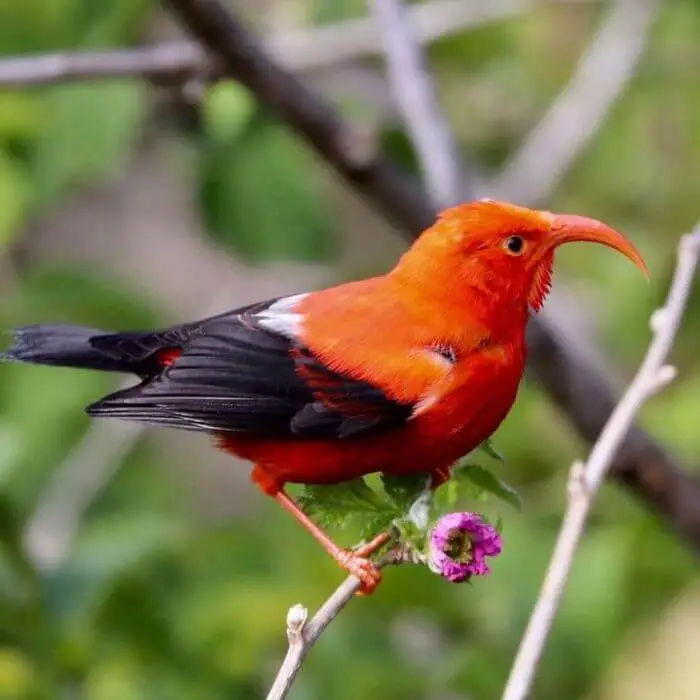
Identification:
In our recent article, we looked at some common birds of the islands and i’iwi was one of them. Native to the Hawaiian islands, this nectar-feeding honeycreeper is an endangered species and is easily recognizable thanks to its bright orange-red feathers and long, curved beak and black wings.
Habitat:
The i’iwi can be found in the Hawaiian Islands, including on the islands of Kauaʻi, Oʻahu, Maui. They favor wet forests.
The i’iwi feeds on nectar from ʻōhiʻa lehua flowers as well as insects like caterpillars and spiders. It has adapted to utilize its long bill for getting deep into flowers for food. These birds also play an important role in spreading pollen between different plants while they feed. Unfortunately, their numbers have decreased due to diseases like avian pox that were introduced by mosquitoes from other areas of the world.
Nesting:
Like the white-capped redstart, they have bluish eggs. However, females typically lay 2 eggs every season, which also contributes to their low population. You can watch their pairing and honeycreeper babies from January to July.
8. Crimson-backed Tanager

Identification:
Common in Panama and Venezuela, the crimson-backed tanager is another type of red bird with black wings. This exotic, vividly colored bird species is closely related to the scarlet tanager above.
Crimson-backed tanagers have long black tails and wings with rounded tips that are ideal for soaring through the sky while searching for food. They have a dark red head and velvety red body. Note their pale bill.
Habitat:
These red and black birds favor gardens and forests. They feed mainly on insects such as beetles, caterpillars, flies, and spiders among other small invertebrates. When perched on a tree branch or shrub they will sunbathe like many other bird species do in order to maintain their body temperature throughout the day.
Nesting:
Like most tanagers, they lay two bluish eggs that hatch after two weeks. Their populations are stable.
9. Brazilian Tanager
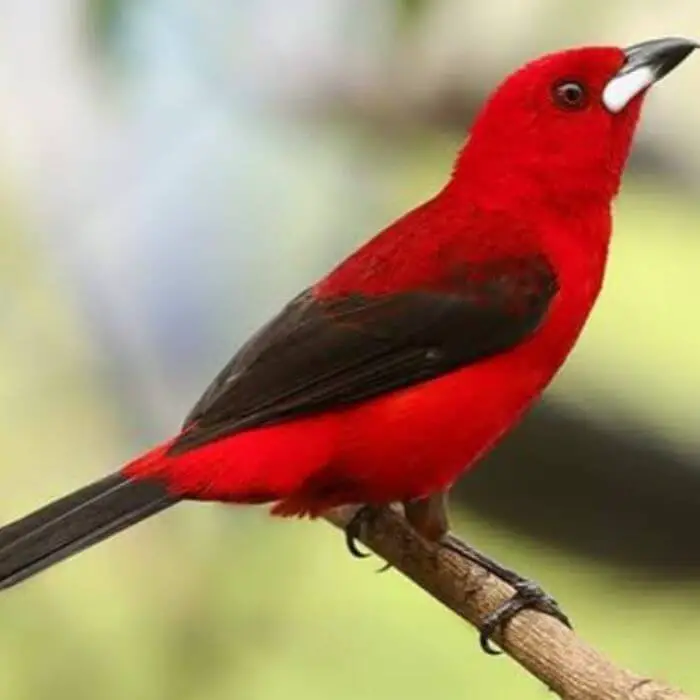
Identification:
Brazilian tanagers are sexually dimorphic. It is a type of bird found exclusively in the forests of South America. This small bird is known for its bright and vibrant colors, with its black and red hue. Females are brown. Its diet consists mostly of fruit, but it will also eat insects if necessary.
As one of the most colorful members of the cardinal family, the Brazilian tanager often stands out in its habitat due to its unique plumage.
Habitat:
In terms of behavior, these birds are quite social and often seen in large flocks that travel together throughout South America’s forests. Their signature vocalizations can be heard over long distances and consist mainly of chirps and low clicks.
Nesting:
Brazilian tanagers build cup-shaped nests and lay up to three greenish eggs.
10. ʻApapane
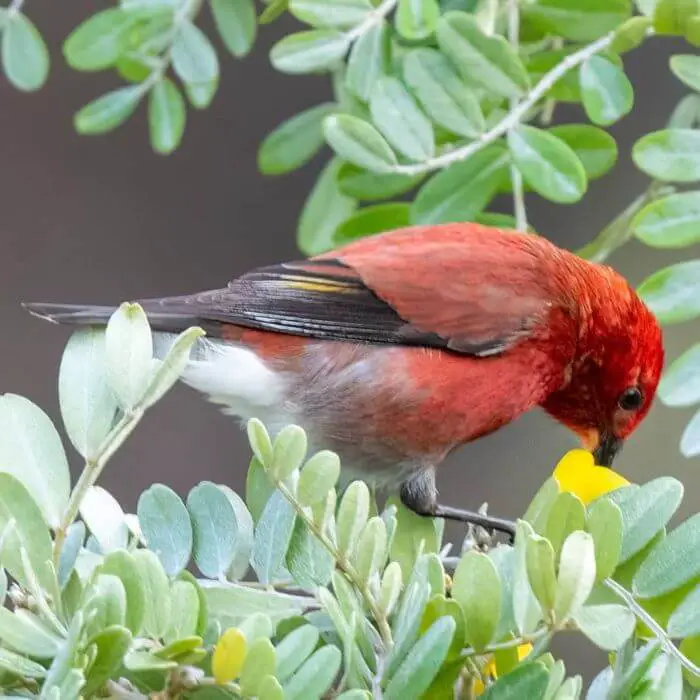
Identification:
Unlike i’iwis, apapanes are common in Maui and Kauai. Apapane is a type of Hawaiian honeycreeper that is best known for its bright red feathers, black wings and tail, and slightly curved beaks. Adults are about 5 inches long and weigh 0.56 oz.
Habitat:
Apapane have adapted to life in the Hawaiian rainforest, where they feed on nectar from ohia lehua flowers and insects found in bark crevices. The bird’s diet is one of the reasons why it has become so successful in its native habitat; another reason is because of its strong social bonds with other birds.
Nesting:
Breeding starts from February through June. Females can lay up to 4 eggs. Note, the males do not hang around the nest but will often search for food and feed his partner off site.
11. Black-winged Lory

Identification:
Biak red lorys or black-winged lory are a member of the eos genus. It is a beautiful, exotic bird with a unique coloration that sets it apart from other species.. With its rainbow of colors and playful personality, the black-winged lory is sure to add a splash of color and charm to any backyard aviary.
This medium-sized bird grows up to 12 inches in length and features a red body with black patches on its wings and black tail. Its head is adorned with vibrant blue feathers on the sides. Additionally, the black-winged lory has an orange beak that blends with the reddish body.
Habitat:
Native to the tropical forests of Indonesia and New Guinea, this parrot-like creature has been gaining in popularity among avian enthusiasts
Nesting:
Black-winged lory females lay two white eggs that they incubate for 25-28 days. The babies leave the nest after about two months.
FAQs
Where are scarlet tanagers found?
The scarlet tanager population is currently stable and widespread throughout the continent, although they can be difficult to spot due to their preference for forested areas.
The main breeding range of the scarlet tanager is east of the Great Plains, stretching from southeastern Canada down into Mexico. This bird migrates south during winter months and can sometimes be seen as far as Panama or Cuba during this time. They prefer deciduous forests with plenty of trees for nesting sites and flycatchers for food sources.
What kind of bird is red with black wings?
One type of red and black winged creature is the Scarlet Tanager. This small passerine species can be found throughout North America during the breeding season in deciduous forests or woodlands where they feed on insects or fruits. It has an unmistakable bright red body with jet-black wings.
Is a scarlet tanager endangered?
The Scarlet Tanager is listed by The International Union for Conservation of Nature (IUCN) as a species of Least Concern, meaning that it does not currently meet criteria for threatened or endangered status.
Do tanagers come to feeders?
Tanagers can indeed be enticed to feeders with a variety of berries including strawberries, blackberries, and juneberries. However, it is important to note that some types of tanagers are more likely than others to visit bird feeders. Setting up your birdfeeder in a location that has plenty of shrubs and trees nearby will help attract even more tanagers – these birds need plenty of cover for protection during their visits!
Where do tanagers nest?
The answer depends on the species of tanager in question. Some species tend to prefer dense forests for their nesting sites, while others may choose more open areas such as farmland or grassland. Some species even construct nests in tree cavities or on cliffs! The materials used by these birds also vary greatly depending on the species; some use leaves and twigs while others may incorporate spider webs and other materials into their creations.
Source:
https://en.wikipedia.org/wiki/Andean_cock-of-the-rock
https://ebird.org/species/blwlor1
Hi fellow bird watcher. Welcome to our small corner of the world. At the spanishbirdguides.com our mission is to share with other bird watchers the things we love about birds, where to go bird watching within the United States, and more. I’d also love to hear from you. Feel free to contact me about your bird watching escapades, share videos, photos and more.
